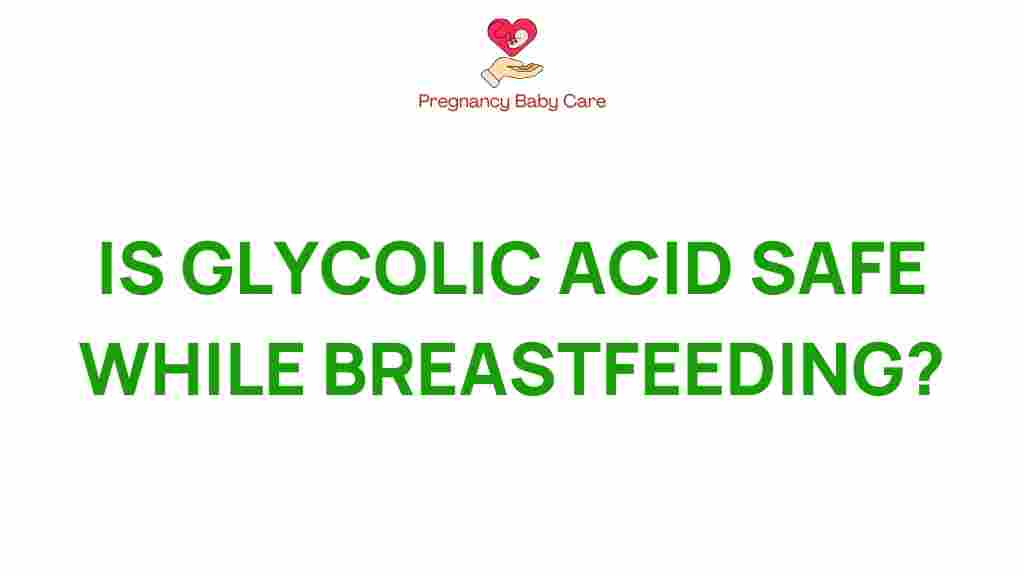Is Glycolic Acid Safe While Breastfeeding? A Comprehensive Overview
As a new mother, your focus often shifts to the health and wellbeing of your baby. This concern extends to everything you consume or apply to your body, including skincare products. One ingredient that frequently comes up in discussions about skincare is glycolic acid. But is glycolic acid safe while breastfeeding? This article aims to uncover the surprising truth about glycolic acid, its implications for breastfeeding safety, and how it fits into your skincare routine during the postpartum period.
Understanding Glycolic Acid
Glycolic acid is an alpha hydroxy acid (AHA) derived from sugar cane. It is known for its exfoliating properties, making it a popular choice in many skincare products, particularly for those looking to improve skin texture and tone. Here’s why glycolic acid is commonly used:
- Exfoliation: Glycolic acid helps slough off dead skin cells, promoting cell turnover.
- Brightening: It can improve skin radiance and reduce the appearance of dark spots.
- Acne Treatment: By unclogging pores, it can help reduce acne breakouts.
The Importance of Ingredient Awareness During Breastfeeding
When it comes to breastfeeding safety, ingredient awareness is crucial. Many mothers are understandably cautious about the products they use, as they can potentially affect their baby’s health. It’s essential to assess the safety of skincare ingredients, especially during this sensitive time. Here are some key considerations:
- **Absorption:** Consider how much of the ingredient is absorbed through the skin.
- **Toxicity:** Evaluate the toxicity levels of the ingredient.
- **Alternatives:** Explore safer alternatives if necessary.
Glycolic Acid and Breastfeeding Safety
When evaluating the safety of glycolic acid for breastfeeding mothers, several factors come into play:
Research on Glycolic Acid and Lactation
Current research indicates that glycolic acid is not known to be harmful when used topically. The concentration of glycolic acid in most skincare products is relatively low, which minimizes the potential for systemic absorption. Here are some findings:
- Studies show that glycolic acid has low skin penetration, which means it’s unlikely to enter the bloodstream in significant amounts.
- According to dermatology experts, topical use of glycolic acid is generally considered safe for lactating mothers.
- However, it is always advisable to consult with a healthcare professional regarding any specific concerns.
Benefits of Using Glycolic Acid While Breastfeeding
Incorporating glycolic acid into your skincare routine can offer several benefits during the postpartum period:
- Improved Skin Texture: Postpartum hormonal changes can lead to uneven skin texture. Glycolic acid can help smooth the skin.
- Reduction of Acne: Hormonal fluctuations may also cause acne flare-ups. Glycolic acid can help keep pores clear.
- Enhanced Radiance: Many mothers experience dull skin after childbirth. Regular use can promote a brighter complexion.
How to Safely Use Glycolic Acid in Your Skincare Routine
If you decide to use glycolic acid while breastfeeding, here are steps to safely incorporate it into your skincare regimen:
- Start with a Patch Test: Before applying any new product, do a patch test to ensure you don’t have an adverse reaction.
- Choose the Right Concentration: Opt for products with a lower concentration (around 5-10%) to minimize any potential irritation.
- Use it Sparingly: Incorporate glycolic acid gradually into your routine, perhaps starting with once a week.
- Moisturize: Always follow up with a good moisturizer to prevent dryness.
- Consult a Dermatologist: If you have specific skin concerns, consider consulting a dermatologist for tailored advice.
Potential Side Effects and Troubleshooting
While glycolic acid is generally safe, some users may experience side effects. Here’s what to watch out for:
- Irritation: Redness, burning, or stinging can occur. If this happens, reduce frequency or concentration.
- Dryness: Glycolic acid can be drying. Ensure your skin is well-hydrated to combat this.
- Sun Sensitivity: AHAs can increase sun sensitivity. Always use sunscreen during the day.
Alternatives to Glycolic Acid
If you are concerned about using glycolic acid while breastfeeding, consider alternatives that also promote healthy skin:
- Lactic Acid: A gentler AHA that hydrates while exfoliating.
- Salicylic Acid: Ideal for acne-prone skin, but consult a healthcare provider for safety during breastfeeding.
- Natural Exfoliants: Ingredients like sugar, coffee grounds, or oatmeal can provide a more gentle exfoliation.
Conclusion: Making Informed Choices for Maternal Health
In conclusion, glycolic acid can be a safe and effective addition to your skincare routine while breastfeeding, provided that it is used correctly and with caution. The key is to maintain ingredient awareness and prioritize your skin’s health without compromising your baby’s safety.
As with any skincare product, it’s wise to consult with your healthcare provider or a dermatologist if you have any concerns. By making informed choices about your skincare, you can embrace your postpartum journey with confidence and care for your skin effectively.
For more information on skincare during breastfeeding, check out this resource. For expert advice on dermatological concerns, visit this site.
This article is in the category Health and created by PregnancyBabyCare Team
